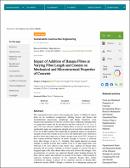| dc.contributor.author | Mugume, Rodgers B. | |
| dc.contributor.author | Karubanga, Adolph | |
| dc.contributor.author | Kyakula, Michael | |
| dc.date.accessioned | 2022-03-01T07:52:07Z | |
| dc.date.available | 2022-03-01T07:52:07Z | |
| dc.date.issued | 2021-10-08 | |
| dc.identifier.citation | Mugume, Rodgers B., Karubanga, Adolph.,Kyakula, Michael (2021). Impact of Addition of Banana Fibres at Varying Fibre Length and Content on Mechanical and Microstructural Properties of Concrete.Advances in Civil Engineering, vol. 2021, Article ID 9422352, 15 pages, 2021. https://doi.org/10.1155/2021/9422352. | en_US |
| dc.identifier.uri | https://doi.org/10.1155/2021/9422352 | |
| dc.identifier.uri | https://kyuspace.kyu.ac.ug/xmlui/handle/20.500.12504/730 | |
| dc.description | 15 p. : col | en_US |
| dc.description.abstract | 'is experimental study aimed at investigating the impact of addition of banana fibres on the mechanical (compression, splitting
tension, and flexure) and microstructural (microscopic morphology and Energy Dispersive X-ray Spectroscopy) properties of
concrete. Concrete mixes comprising of banana fibres of varying fibre lengths (40, 50, and 60 mm) and fibre contents (0.1, 0.2, 1.0,
1.5, and 2.5%) were assessed. Addition of banana fibres to concrete was observed to significantly impact on compressive strength
only at lower fibre contents of up to 0.25% for all fibre lengths. Fibre length had no significant impact on compressive strength at
lower fibre contents of up to 0.25%, but shorter fibres were observed to perform better than longer ones at higher dosages more
than 0.25%. Increase in fibre content positively impacted on tensile strength of concrete at relatively lower fibre dosages of up to
1%. Similarly, fibre length impacted on tensile strength of concrete at lower fibre contents of up to 1% and, longer fibres were
observed to be more effective than shorter ones. Addition of banana fibres generally did not greatly contribute to flexural strength
of concrete but had a marginal impact only when shorter fibres were used at lower fibre dosages. Also, microstructure of concrete
was improved through better bonding between the fibres and the matrix and reduction in porosity of the matrix, which resulted in
improved mechanical properties of the composite. Banana fibres further contributed to changes in phases of the composite
structure of Banana fibre-reinforced concrete (BFRC) through a reduction in its interplanar spacing and lattice structure. For
optimal purposes, addition of banana fibres should be limited to a maximum of 1% fibre content preferably using shorter fibre
lengths. Further research to improve flexural strength of BFRC to meet minimum technical requirements is required before it can
be considered for structural applications | en_US |
| dc.language.iso | en | en_US |
| dc.publisher | Hindawi: Advances in Civil Engineering | en_US |
| dc.subject | Banana fibres | en_US |
| dc.subject | Fibre | en_US |
| dc.subject | Mechanical and Microstructural Concrete | en_US |
| dc.title | Impact of addition of banana fibres at varying fibre length and content on mechanical and microstructural properties of concrete | en_US |
| dc.type | Article | en_US |

